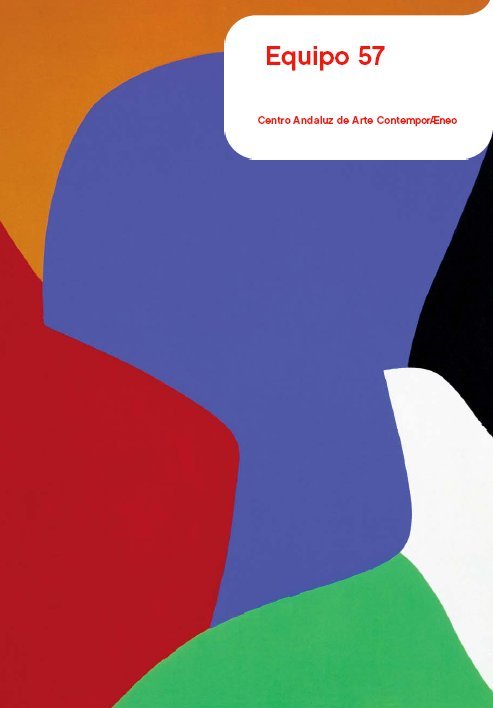Equipo 57
dal 18/12/2007 al 1/3/2008
Segnalato da
Centro Andaluz de Arte Contemporaneo
18/12/2007
Equipo 57
Centro Andaluz de Arte Contemporaneo, Sevilla
Group show

Half a century has passed since the creation
in May 1957 in Paris, of the Equipo 57
collective of young, committed Spanish
artists who had travelled to the French
capital attracted by its cultural dynamism,
anxious to discover the artistic avant-gardes
and to find ways in which to channel their
aesthetic concerns, so enormously different
to the localist Spanish tradition fomented by
the Franco regime in the post-war years.
Ángel Duarte (Aldeanueva del Camino,
Cáceres, 1930 - Sion, Switzerland, 2007),
Agustín Ibarrola (Bilbao 1930) and from
Córdoba Juan Serrano (1929) and José
Duarte (1928) met in 1957 in Paris, where they
were soon to work along the same
conceptual lines, partly because of the
influence exercised by the sculptor Jorge de
Oteiza, from whom they were to become
estranged that same year as a result of the
publication of the group's first radical
manifesto. In it they denounced mercantilism
in art and the stagnation of plastic forms and
proposed a collective approach without
personalisms or individual authorship. The group was joined a little later by Juan Cuenca,
also from Córdoba (Puente Genil, 1934), who
remained until its dissolution in 1962.
Meanwhile, on the international art scene the
last episodes of the struggle between New
York and Paris were being fought out for
cultural hegemony after the Second World
War. A strong new identity was becoming
consolidated on the other side of the Atlantic,
heir to European modernity, but increasingly
independent in its artistic and cultural
manifestations and identifying with action
painting as its own culture. At the same time,
in Europe, informalism was developing as
various expressive tendencies revealing the
anguish and despair of the post-war years.
Both attitudes showed neither prior structure
nor control of the emotions when confronting
the picture surface.
However, in the 1950's other circles in
Europe and South America were speculating
with artistic criteria of another dimension,
centred on notions such as mobility, change
or synthesis, seeking, in the words of Miklos
Pasternak "a recontextualisation of the
categories of space, light, movement and
temporality, in sum, the attempt to set the starting point for a new origin" (1). This
attitude led to the formation of such
research groups as Arte Concreta in Milan,
Espace in Paris, Exat in Zagreb, Gutai in
Japan, Equipo 57 in Spain, Gruppe Zero in
Germany, etc. The investigations carried out
by these collectives can be considered as
attempts to break with the type of dramatic
narration typical of the individualist
expressionisms.
So Equipo 57 was to move along these paths,
attempting to reconcile plastic investigation
with scientific reflection, for which they
adopted a work practice based on prior
discussion and research before the
collective execution of the art works.
The need to expand plastic space led them
to formulate the Theory of Interactivity, in
which they stated that form, colour, line and
mass do not exist as independent elements,
but that everything is space, differentiated
by its dynamic function. Form-Space is
reduced to space-colour in painting and to
space-mass and space-air in sculpture, each
one the result of an interdependence.
This theory can be seen in operation in the
abstract film Interactividad I, shown in the
exhibition and made in 1957 using over 400
collectively painted watercolours (some of
which are also on show) arranged as frames
to produce the sensation of movement.
Equipo 57 created different paintings and
sculptures. In their evolution, the former
began with a preponderance of straight and
curved lines separating the different colour
planes, which gradually became arranged
according to a more serial concept. The first sculptures, on the other hand, were pieces
with mass and volume of organic appearance
that could connect with the work of Hans Arp,
until research centred on the interrelations
between planes and surfaces using materials
such as galvanized wire rods or plaster.
Although references to the constructivists
Naum Gabo and Anton Pevsner are inevitable
when using paraboloids, Equipo 57 moved
away from them by overcoming the Russians
sculptors' plane limitations and discovering
that by juxtaposing two or more hyperbolic
paraboloids they produced a spatial
continuity of double curvature that gave their
pieces greater dynamism.
The practical application of their theories led
Equipo 57 to design prototypes of functional
furniture that could easily be set up and
dismantled using assemblages of parts. They
were awarded prizes and exhibited just as
any work of art together with the team's
pieces of painting and sculpture in different
galleries in Madrid and Córdoba.
During its short life, Equipo 57's activity was
intense, as was its international projection.
Apart from their reflections, investigations
and works, created and shown at prestigious
galleries in Paris, Copenhagen, Zurich,
Brussels and Spanish cities such as Madrid,
Córdoba, Barcelona and Valencia, their work
as agitators by Equipo 57 was equally
important for the formation of other artistic
groups sharing their spirit of social and
political commitment. Likewise, they brought
about social transformations such as the
radical change in methods of teaching the
arts.
Through their lectures, encounters,
debates and publications, which are
fortunately stored in the archives, we can
understand the coherence of their essential
ideas, on which they based their
experimental attitude and their peculiar
sense of historical dialectics.
Centro Andaluz de Arte Contemporaneo
Monasterio de la Cartuja de Santa María de las Cuevas
Avda. Américo Vespucio n 2
Isla de la Cartuja - 41092 Sevilla
Tuesday to Friday: 10 - 20 h.
Saturday: 11 - 20 h.
Sundays: 10 - 15 h.
Monday: closed.



